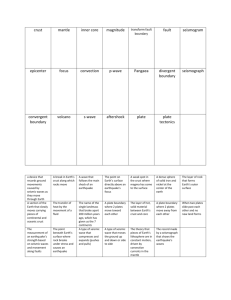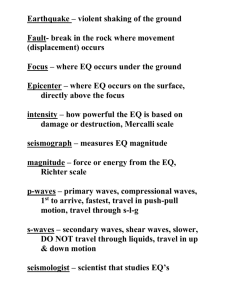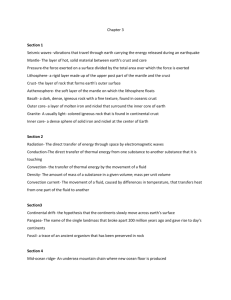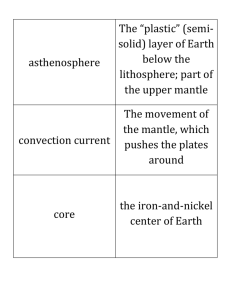DP Answer Key
advertisement
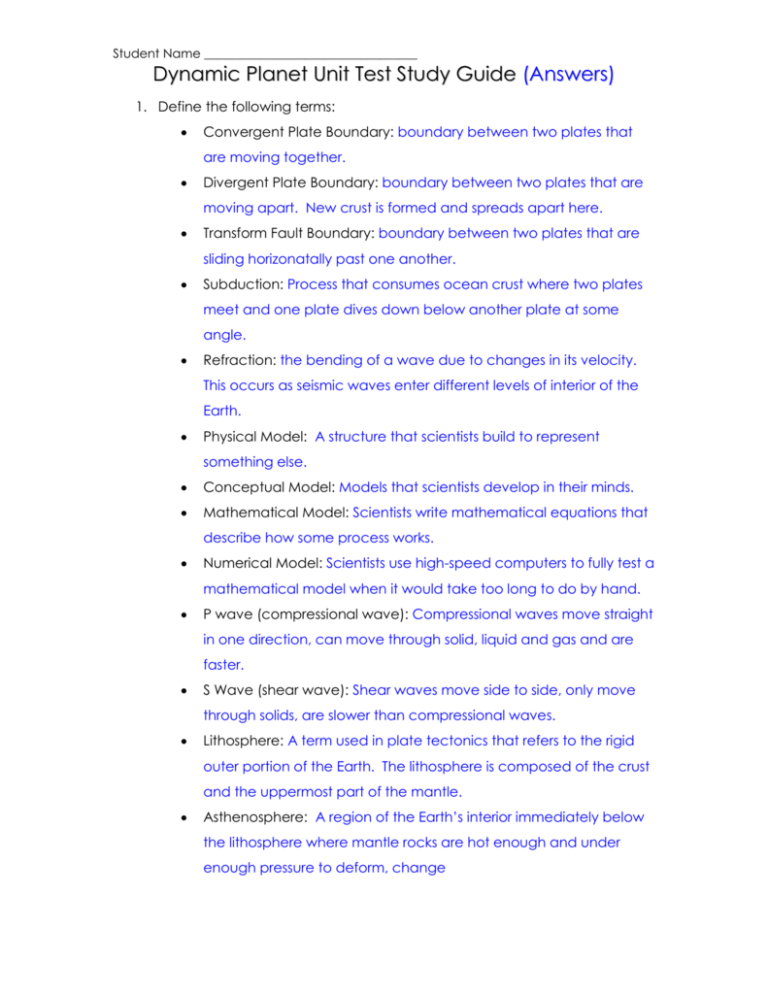
Student Name __________________________________ Dynamic Planet Unit Test Study Guide (Answers) 1. Define the following terms: Convergent Plate Boundary: boundary between two plates that are moving together. Divergent Plate Boundary: boundary between two plates that are moving apart. New crust is formed and spreads apart here. Transform Fault Boundary: boundary between two plates that are sliding horizonatally past one another. Subduction: Process that consumes ocean crust where two plates meet and one plate dives down below another plate at some angle. Refraction: the bending of a wave due to changes in its velocity. This occurs as seismic waves enter different levels of interior of the Earth. Physical Model: A structure that scientists build to represent something else. Conceptual Model: Models that scientists develop in their minds. Mathematical Model: Scientists write mathematical equations that describe how some process works. Numerical Model: Scientists use high-speed computers to fully test a mathematical model when it would take too long to do by hand. P wave (compressional wave): Compressional waves move straight in one direction, can move through solid, liquid and gas and are faster. S Wave (shear wave): Shear waves move side to side, only move through solids, are slower than compressional waves. Lithosphere: A term used in plate tectonics that refers to the rigid outer portion of the Earth. The lithosphere is composed of the crust and the uppermost part of the mantle. Asthenosphere: A region of the Earth’s interior immediately below the lithosphere where mantle rocks are hot enough and under enough pressure to deform, change Student Name __________________________________ Convection: The density-driven movement of a fluid material. Mantle convection plays an important role in moving Earth’s lithospheric plates. Epicenter: the epicenter of an earthquake is the point on the Earth’s surface directly above the focus. Focus: it is the point below the Earth's surface where seismic waves originate during an earthquake. Magma: term used for molten rock within the Earth Trenches: A common geological feature found near subduction zones on the ocean floor, characterized as deep narrow openings. Shadow Zones: areas where no seismic waves can be detected. Continent-Continent collision zone: places where the continents are thickest. At this point, one plate is slowly being pushed under another. Mountains form at these zones. 2. What is the difference between oceanic crust and continental crust? Continental crust is older, less dense and thicker than the oceanic crust. 3. What is the difference between the Earth’s crust and mantle? What are the similarities? The earth’s crust and mantle have different densities. 4. List the Earth’s layers from the center to the surface. Inner core, outer core, mantle, crust 5. What is the difference between the inner core and the outer core? The outer core is made of high-temperature liquid iron. The inner core is solid. 6. What can an earthquake on the sea floor produce? tsunami 7. What was the name of Alfred Wegener’s theory of horizontal movement of the Earth’s crust? Continental drift 8. What were the key points of this theory? What evidence did he have? The continents’ positions on the globe are not fixed and that the continents have moved (and continue to move) about the globe during the course of geologic time. His evidence was: Distribution of fossil plants and animals in the ocean Geographic fit of the continents Pattern of earthquakes and volcanoes along the “Ring of Fire” Student Name __________________________________ 9. What was the name of Wegener’s proposed single super continent? Pangea 10. Why did scientists reject his theory? They believed there was a lack of a mechanism for the continents to plow through oceanic crusts. 11. The San Andreas fault is an example of what kind of plate boundary? Transform fault boundary 12. How fast do Earth’s lithospheric plates move in one year? About 5 cm each year 13. How are seismic waves on Earth detected? By seismographs at seismograph stations

